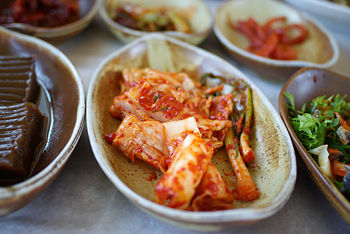Kimchi: Difference between revisions
imported>Chunbum Park No edit summary |
imported>Chunbum Park |
||
| Line 3: | Line 3: | ||
== History == | == History == | ||
Kimchi appeared | Kimchi first appeared in Korea around the 7th century. The early form of Kimchi was salted vegetable, and it is theorized that the dish was originally called ''shimchae'', meaning "salting of vegetable." The name underwent a few phonetic changes over the centuries, to ''dimchae'', ''kimchae'', and finally ''kimchi''.<ref name="historytourism">[http://english.visitkorea.or.kr/enu/FO/FO_EN_6_1_2_1.jsp History of Kimchi], Korea Sparkling. Date accessed: 2009-03-10</ref> | ||
"Summer kimchi" is made from leaves and cores of the [[cabbage]] family, while "winter kimchi" is based on white [[radish]]es of the [[daikon]] family. | "Summer kimchi" is made from leaves and cores of the [[cabbage]] family, while "winter kimchi" is based on white [[radish]]es of the [[daikon]] family. | ||
Revision as of 11:04, 10 March 2009
Kimchi (김치), also transliterated as "kimchee", is actually a family of Korean vegetable-based pickles. They are a basic part of Korean cuisine, with many variants, although usually strongly flavored, featuring garlic and hot peppers. Kimchi is a key ingredient for Korean dishes such as kimchi stew and kimchi pancake and is often eaten by Koreans with ramen noodles and gimbap rolls. The side dish is generally considered very healthy due to its lactic acid bacterias, antioxidants, and high fiber content. Although it is widely accepted that the advantages of eating kimchi include improved digestion and bowel function, other benefits, such as increased immunity and reduced chance of cancer, are disputed due to contradicting studies or lack of concrete evidence.[1] In 2008, the Health Magazine listed kimchi as one of the five healthiest foods in the world.[2]
History
Kimchi first appeared in Korea around the 7th century. The early form of Kimchi was salted vegetable, and it is theorized that the dish was originally called shimchae, meaning "salting of vegetable." The name underwent a few phonetic changes over the centuries, to dimchae, kimchae, and finally kimchi.[3]
"Summer kimchi" is made from leaves and cores of the cabbage family, while "winter kimchi" is based on white radishes of the daikon family.
notes
- ↑ Koreans’ Kimchi Adulation, With a Side of Skepticism, Barbara Demick, Los Angeles Times, 2006-05-21.
- ↑ "World’s Healthiest Foods: Kimchi (Korea)", Joan Raymond, Health Magazine. 2008-02-01.
- ↑ History of Kimchi, Korea Sparkling. Date accessed: 2009-03-10
